WSH Regulations & Noise in Garage: A Sociology Report Analysis
VerifiedAdded on 2023/03/17
|16
|3822
|72
Report
AI Summary
This sociology report examines the application of noise regulations within a garage environment, treating it as a lab setting to analyze sound level variations and their impact. It investigates permissible exposure limits, the role of stakeholders in boundary noise limits, and the social and health effects of noise. The report identifies strategies for measuring, reducing, and controlling noise within the garage and its surroundings, emphasizing the role of organizations in noise monitoring through Workplace Safety and Health (WHS) regulations. By analyzing the sound effects in a garage, the report measures noise levels in the work environment and surrounding areas, providing a clear definition of WHS regulations and offering recommendations for future investigations into noise management in workshops. The study considers existing literature on workplace safety, noise as a health hazard, and relevant regulations such as the Singapore Environmental Protection and Management Act and Workplace Safety and Health Act, ultimately aiming to provide solutions for noise reduction and improved workplace safety.
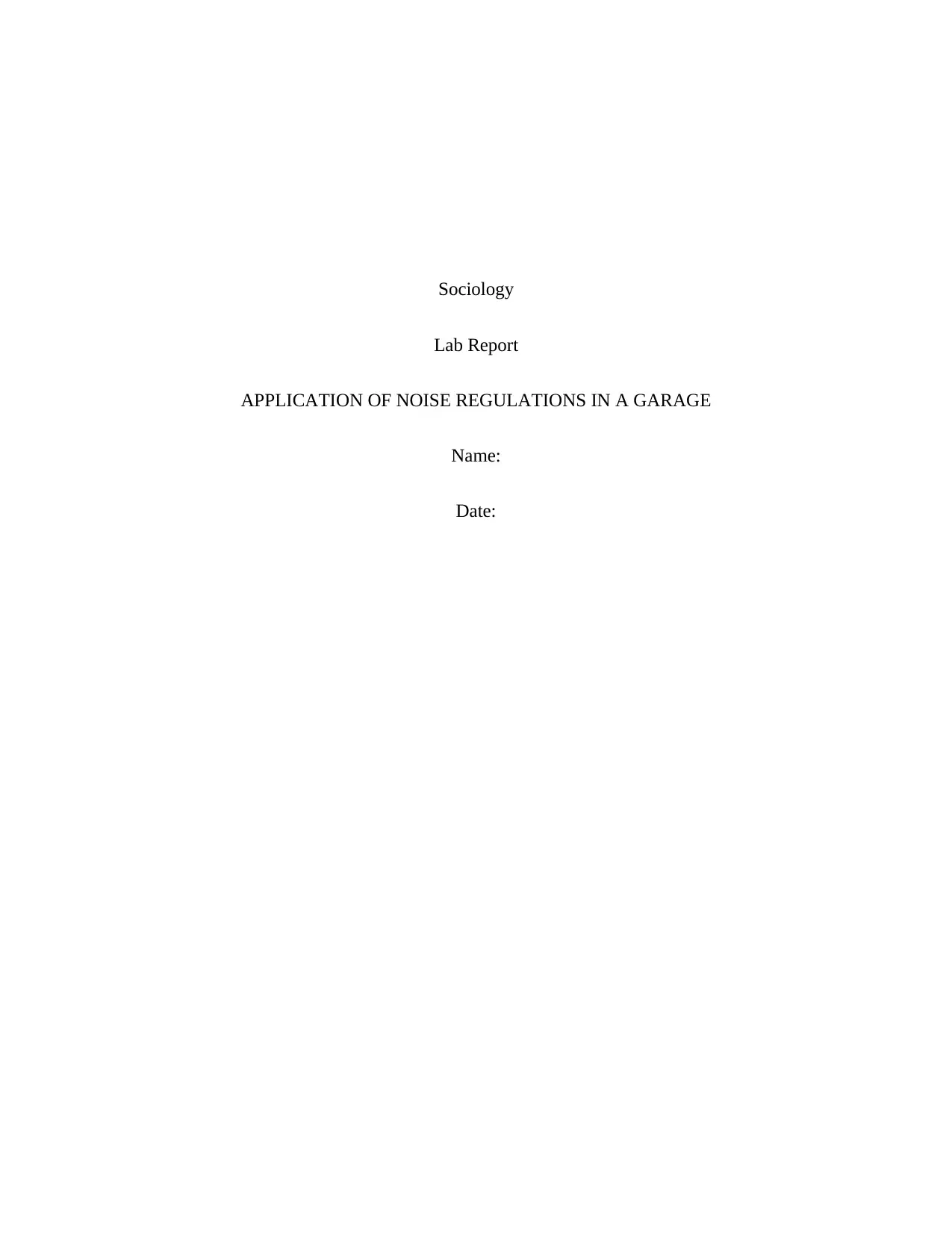
Sociology
Lab Report
APPLICATION OF NOISE REGULATIONS IN A GARAGE
Name:
Date:
Lab Report
APPLICATION OF NOISE REGULATIONS IN A GARAGE
Name:
Date:
Paraphrase This Document
Need a fresh take? Get an instant paraphrase of this document with our AI Paraphraser
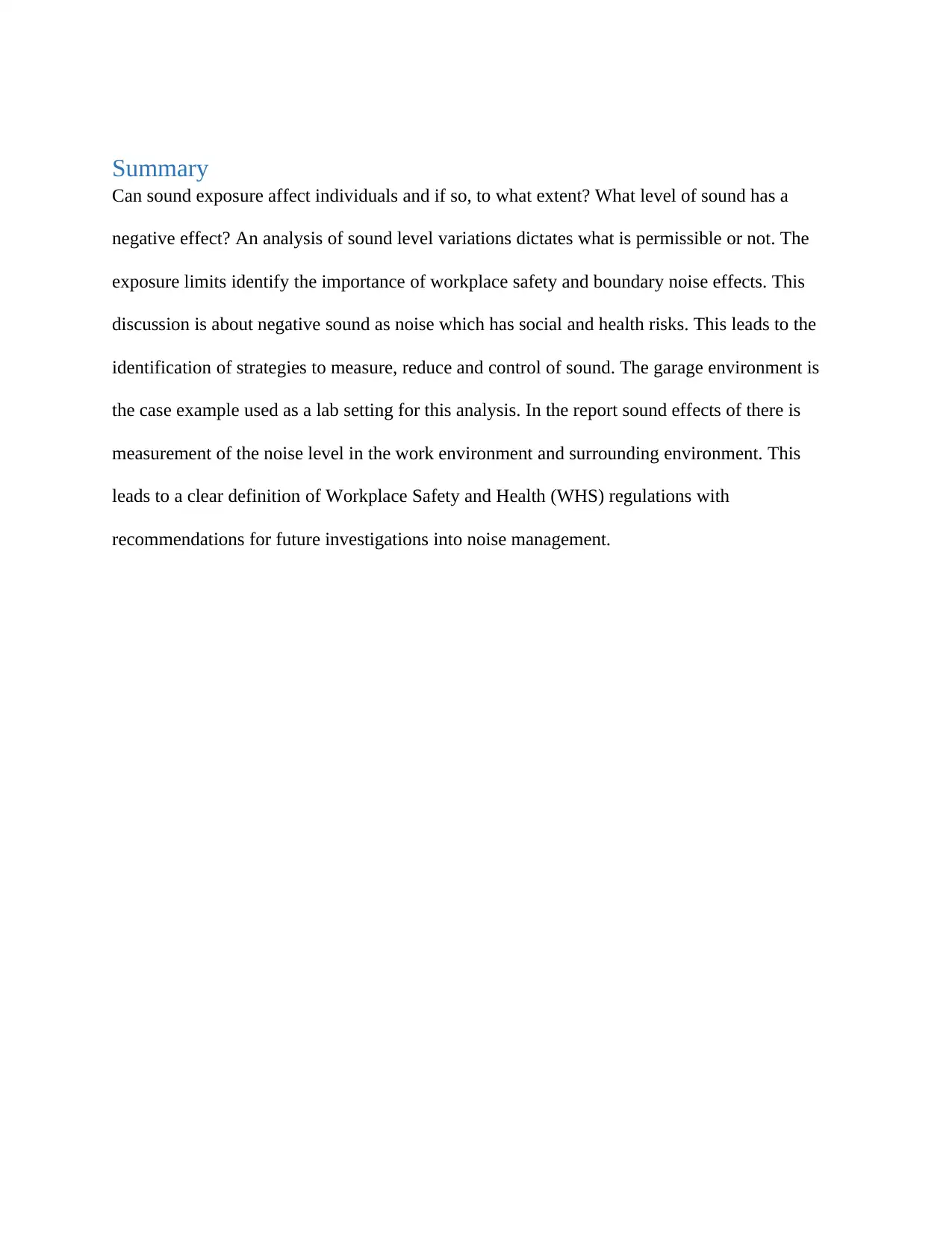
Summary
Can sound exposure affect individuals and if so, to what extent? What level of sound has a
negative effect? An analysis of sound level variations dictates what is permissible or not. The
exposure limits identify the importance of workplace safety and boundary noise effects. This
discussion is about negative sound as noise which has social and health risks. This leads to the
identification of strategies to measure, reduce and control of sound. The garage environment is
the case example used as a lab setting for this analysis. In the report sound effects of there is
measurement of the noise level in the work environment and surrounding environment. This
leads to a clear definition of Workplace Safety and Health (WHS) regulations with
recommendations for future investigations into noise management.
Can sound exposure affect individuals and if so, to what extent? What level of sound has a
negative effect? An analysis of sound level variations dictates what is permissible or not. The
exposure limits identify the importance of workplace safety and boundary noise effects. This
discussion is about negative sound as noise which has social and health risks. This leads to the
identification of strategies to measure, reduce and control of sound. The garage environment is
the case example used as a lab setting for this analysis. In the report sound effects of there is
measurement of the noise level in the work environment and surrounding environment. This
leads to a clear definition of Workplace Safety and Health (WHS) regulations with
recommendations for future investigations into noise management.

Contents
Summary.....................................................................................................................................................2
Introduction.................................................................................................................................................4
a) purpose............................................................................................................................................4
b) Background information..................................................................................................................5
Literature Review........................................................................................................................................7
Permissible sound and exposure limits................................................................................................7
Organizational safety...........................................................................................................................8
Environmental strategies.....................................................................................................................8
Methods.......................................................................................................................................................9
Results.......................................................................................................................................................10
Uncertainties..............................................................................................................................................10
Analysis.....................................................................................................................................................10
Conclusion.................................................................................................................................................11
Bibliography..............................................................................................................................................13
Summary.....................................................................................................................................................2
Introduction.................................................................................................................................................4
a) purpose............................................................................................................................................4
b) Background information..................................................................................................................5
Literature Review........................................................................................................................................7
Permissible sound and exposure limits................................................................................................7
Organizational safety...........................................................................................................................8
Environmental strategies.....................................................................................................................8
Methods.......................................................................................................................................................9
Results.......................................................................................................................................................10
Uncertainties..............................................................................................................................................10
Analysis.....................................................................................................................................................10
Conclusion.................................................................................................................................................11
Bibliography..............................................................................................................................................13
⊘ This is a preview!⊘
Do you want full access?
Subscribe today to unlock all pages.

Trusted by 1+ million students worldwide

Introduction
Human beings use hearing as one of the senses used for effective communication. However,
working in a noisy environment has side effects that could become a health hazard. People
exposed to too much noise may experience hearing loss and in some cases this vibration
produces other health effects-including changes in blood pressure. As a result, organizations
adopt health and safety regulations to limit this exposure to loud sound. There are sound level
checks based on the sound exposure duration. Mechanical workshops such as a car garage cannot
operate without noise. Workshop activities such as panel beating, welding, spraying and flame
cutting produce different sounds that could be harmful to humans. Machine operations affect
people within the working environment as well as those in the surrounding area. Noise mapping
looks at the sound level and rate of exposure for employees and the environment in order to
prevent damaging effects. So can a car workshop control this sound exposure? What safety
control measures can an organization employ for hearing protection? What level of sound is
appropriate for employees who work in the garage on a daily basis? Which industry regulations
influence professional workshops when designing a garage? This paper looks at these questions
among others.
a) purpose
A car workshop is a mechanical inspection service unit that involves a rigorous exercise with
sound effects. This is a lab with environmental risks featuring noise pollutants. Characterized by
hooting, banging, vibrating and reviving engines, a garage needs sound checks against excessive
noise exposure. When analyzing sound effects for noise control, it is important to consider the
workshop location. Some workshops are within a commercial building while some may be in a
Human beings use hearing as one of the senses used for effective communication. However,
working in a noisy environment has side effects that could become a health hazard. People
exposed to too much noise may experience hearing loss and in some cases this vibration
produces other health effects-including changes in blood pressure. As a result, organizations
adopt health and safety regulations to limit this exposure to loud sound. There are sound level
checks based on the sound exposure duration. Mechanical workshops such as a car garage cannot
operate without noise. Workshop activities such as panel beating, welding, spraying and flame
cutting produce different sounds that could be harmful to humans. Machine operations affect
people within the working environment as well as those in the surrounding area. Noise mapping
looks at the sound level and rate of exposure for employees and the environment in order to
prevent damaging effects. So can a car workshop control this sound exposure? What safety
control measures can an organization employ for hearing protection? What level of sound is
appropriate for employees who work in the garage on a daily basis? Which industry regulations
influence professional workshops when designing a garage? This paper looks at these questions
among others.
a) purpose
A car workshop is a mechanical inspection service unit that involves a rigorous exercise with
sound effects. This is a lab with environmental risks featuring noise pollutants. Characterized by
hooting, banging, vibrating and reviving engines, a garage needs sound checks against excessive
noise exposure. When analyzing sound effects for noise control, it is important to consider the
workshop location. Some workshops are within a commercial building while some may be in a
Paraphrase This Document
Need a fresh take? Get an instant paraphrase of this document with our AI Paraphraser

residential location. In this case, stakeholders involved monitor background noise. The objectives
of this investigation are:
analyzing sound level variations for Permissible Exposure Limits
identify the role of external stakeholders and boundary noise limits
identification of social and health (mental and biological) effects of sound
identification of strategies for measurement, reduction and control of sound in a garage
and its environs
to define the role of organizations in noise monitoring through Workplace Safety and
Health (WHS) regulations
to make recommendations for future investigations noise management in workshops
b) Background information
Noise pollution continues to raise concerns across the world. Consequently there is the need to
minimize the health effects of noise exposure in different environments (Hammer, et al., 2014).
Literature on workplace safety and sound identify noise as detrimental to human health and
workplace productivity (Aletta & Kang, 2015). Policy documents promote safety in human
environment by preventing the undesirable situations and outcomes. The Singapore
Environmental Protection and Management Act is a government regulatory measure describing
the context within which noise occurs (Environmental Pollution Control Act, 1999). This
includes measurement of the noise and penalty costs for noise sensitivity in residential,
commercial and factory premises. A car workshop may exist in an indoor or an external
environment. Each environmental setting is prone to produce varied sound effects. Checking for
of this investigation are:
analyzing sound level variations for Permissible Exposure Limits
identify the role of external stakeholders and boundary noise limits
identification of social and health (mental and biological) effects of sound
identification of strategies for measurement, reduction and control of sound in a garage
and its environs
to define the role of organizations in noise monitoring through Workplace Safety and
Health (WHS) regulations
to make recommendations for future investigations noise management in workshops
b) Background information
Noise pollution continues to raise concerns across the world. Consequently there is the need to
minimize the health effects of noise exposure in different environments (Hammer, et al., 2014).
Literature on workplace safety and sound identify noise as detrimental to human health and
workplace productivity (Aletta & Kang, 2015). Policy documents promote safety in human
environment by preventing the undesirable situations and outcomes. The Singapore
Environmental Protection and Management Act is a government regulatory measure describing
the context within which noise occurs (Environmental Pollution Control Act, 1999). This
includes measurement of the noise and penalty costs for noise sensitivity in residential,
commercial and factory premises. A car workshop may exist in an indoor or an external
environment. Each environmental setting is prone to produce varied sound effects. Checking for
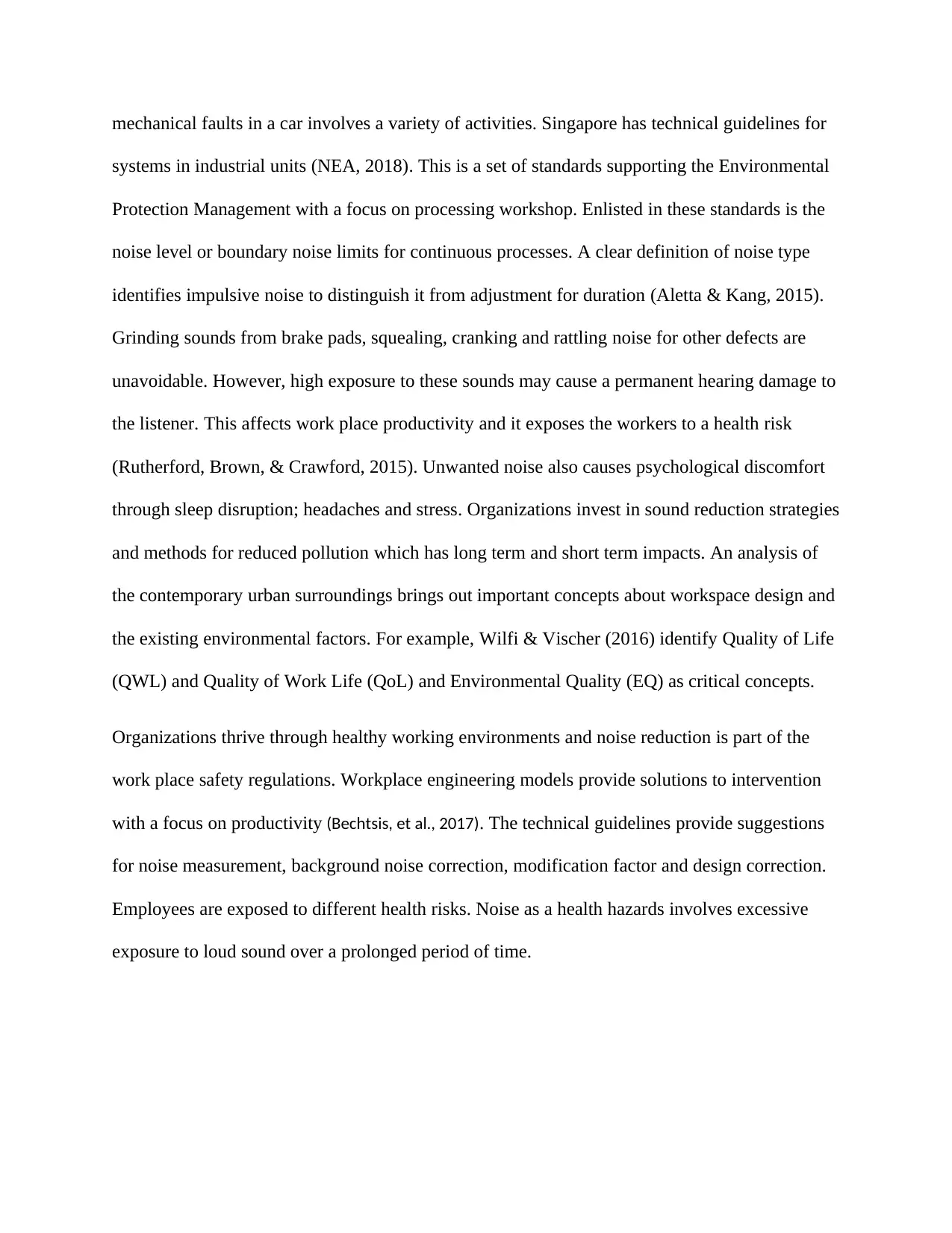
mechanical faults in a car involves a variety of activities. Singapore has technical guidelines for
systems in industrial units (NEA, 2018). This is a set of standards supporting the Environmental
Protection Management with a focus on processing workshop. Enlisted in these standards is the
noise level or boundary noise limits for continuous processes. A clear definition of noise type
identifies impulsive noise to distinguish it from adjustment for duration (Aletta & Kang, 2015).
Grinding sounds from brake pads, squealing, cranking and rattling noise for other defects are
unavoidable. However, high exposure to these sounds may cause a permanent hearing damage to
the listener. This affects work place productivity and it exposes the workers to a health risk
(Rutherford, Brown, & Crawford, 2015). Unwanted noise also causes psychological discomfort
through sleep disruption; headaches and stress. Organizations invest in sound reduction strategies
and methods for reduced pollution which has long term and short term impacts. An analysis of
the contemporary urban surroundings brings out important concepts about workspace design and
the existing environmental factors. For example, Wilfi & Vischer (2016) identify Quality of Life
(QWL) and Quality of Work Life (QoL) and Environmental Quality (EQ) as critical concepts.
Organizations thrive through healthy working environments and noise reduction is part of the
work place safety regulations. Workplace engineering models provide solutions to intervention
with a focus on productivity (Bechtsis, et al., 2017). The technical guidelines provide suggestions
for noise measurement, background noise correction, modification factor and design correction.
Employees are exposed to different health risks. Noise as a health hazards involves excessive
exposure to loud sound over a prolonged period of time.
systems in industrial units (NEA, 2018). This is a set of standards supporting the Environmental
Protection Management with a focus on processing workshop. Enlisted in these standards is the
noise level or boundary noise limits for continuous processes. A clear definition of noise type
identifies impulsive noise to distinguish it from adjustment for duration (Aletta & Kang, 2015).
Grinding sounds from brake pads, squealing, cranking and rattling noise for other defects are
unavoidable. However, high exposure to these sounds may cause a permanent hearing damage to
the listener. This affects work place productivity and it exposes the workers to a health risk
(Rutherford, Brown, & Crawford, 2015). Unwanted noise also causes psychological discomfort
through sleep disruption; headaches and stress. Organizations invest in sound reduction strategies
and methods for reduced pollution which has long term and short term impacts. An analysis of
the contemporary urban surroundings brings out important concepts about workspace design and
the existing environmental factors. For example, Wilfi & Vischer (2016) identify Quality of Life
(QWL) and Quality of Work Life (QoL) and Environmental Quality (EQ) as critical concepts.
Organizations thrive through healthy working environments and noise reduction is part of the
work place safety regulations. Workplace engineering models provide solutions to intervention
with a focus on productivity (Bechtsis, et al., 2017). The technical guidelines provide suggestions
for noise measurement, background noise correction, modification factor and design correction.
Employees are exposed to different health risks. Noise as a health hazards involves excessive
exposure to loud sound over a prolonged period of time.
⊘ This is a preview!⊘
Do you want full access?
Subscribe today to unlock all pages.

Trusted by 1+ million students worldwide

Literature Review
Qualitative and quantitative data highlights general issues relating to noise as a workplace
menace (Skogstad, Johannssen, Tynes, Mehlum, Nordby, & Lie, 2016: Becker, et al. 2016). Data
sources describe the level of unwanted sounds within a specific work environment (Aletta &
Kang, 2015). The existence of a national strategy means society has to work within the stipulated
sound limits (Environmental Pollution Control Act, 1999: NEA, 2018: Gazette, 2011). Direct
regulations are workable depending on the costs and implementation capability. Therefore
effective noise reduction integrates solutions in order to address public needs, stakeholders and
government expectations (Becker, et al., 2016: Hammer, et al., 2014). Consideration for health
risks is important hence the social impact is critical in assessing the impact.
Permissible sound and exposure limits
This discussion analyses literature that identifies sound as a stressful and detrimental element
(Wilfi & Vischer, 2016). A core-relational study confirms the control variables interpreting the
intervention strategies (Becker, et al. 2016). Based on government regulations, these control
elements outline the basic framework for adoption in work environments. Chapter 354A of the
Singapore Workplace Safety and Health Act indicates the duty of manufacturers as well as
stakeholders who deal with noisy machines (Gazette, 2011). Part 3 identifies solutions for noise
in a car garage by suggesting a monitoring process, hearing protectors and a training plan to
reduce the risks. The relevant or affected person in the analysis is the one exposed to the noise
hence the monitoring target (Maryn, et al., 2017). Limits for day and night sound exposure per
hour prevent health and environmental hazards by analysing the noise levels and factors
associated with its effects (Flamme, et al., 2012).
Qualitative and quantitative data highlights general issues relating to noise as a workplace
menace (Skogstad, Johannssen, Tynes, Mehlum, Nordby, & Lie, 2016: Becker, et al. 2016). Data
sources describe the level of unwanted sounds within a specific work environment (Aletta &
Kang, 2015). The existence of a national strategy means society has to work within the stipulated
sound limits (Environmental Pollution Control Act, 1999: NEA, 2018: Gazette, 2011). Direct
regulations are workable depending on the costs and implementation capability. Therefore
effective noise reduction integrates solutions in order to address public needs, stakeholders and
government expectations (Becker, et al., 2016: Hammer, et al., 2014). Consideration for health
risks is important hence the social impact is critical in assessing the impact.
Permissible sound and exposure limits
This discussion analyses literature that identifies sound as a stressful and detrimental element
(Wilfi & Vischer, 2016). A core-relational study confirms the control variables interpreting the
intervention strategies (Becker, et al. 2016). Based on government regulations, these control
elements outline the basic framework for adoption in work environments. Chapter 354A of the
Singapore Workplace Safety and Health Act indicates the duty of manufacturers as well as
stakeholders who deal with noisy machines (Gazette, 2011). Part 3 identifies solutions for noise
in a car garage by suggesting a monitoring process, hearing protectors and a training plan to
reduce the risks. The relevant or affected person in the analysis is the one exposed to the noise
hence the monitoring target (Maryn, et al., 2017). Limits for day and night sound exposure per
hour prevent health and environmental hazards by analysing the noise levels and factors
associated with its effects (Flamme, et al., 2012).
Paraphrase This Document
Need a fresh take? Get an instant paraphrase of this document with our AI Paraphraser
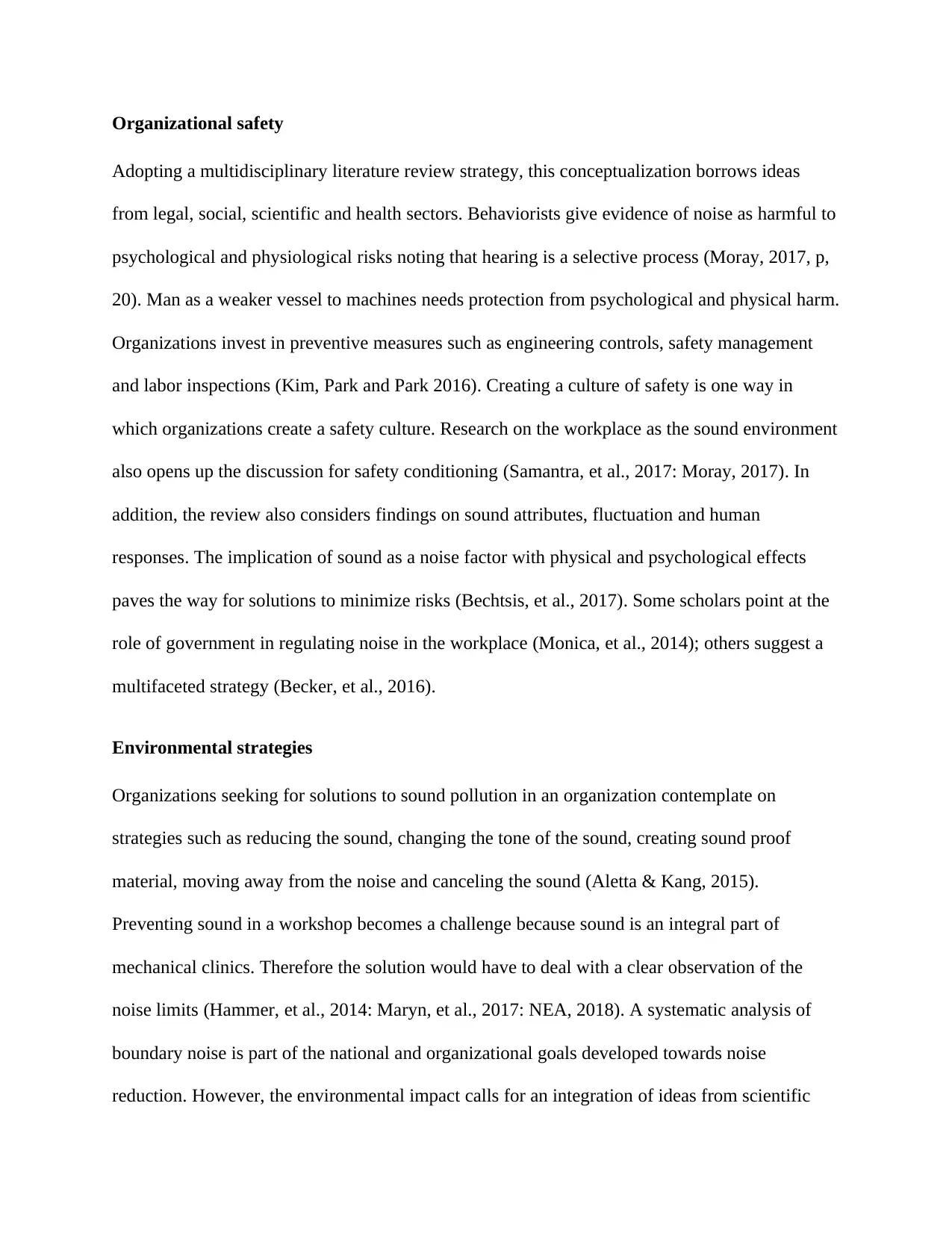
Organizational safety
Adopting a multidisciplinary literature review strategy, this conceptualization borrows ideas
from legal, social, scientific and health sectors. Behaviorists give evidence of noise as harmful to
psychological and physiological risks noting that hearing is a selective process (Moray, 2017, p,
20). Man as a weaker vessel to machines needs protection from psychological and physical harm.
Organizations invest in preventive measures such as engineering controls, safety management
and labor inspections (Kim, Park and Park 2016). Creating a culture of safety is one way in
which organizations create a safety culture. Research on the workplace as the sound environment
also opens up the discussion for safety conditioning (Samantra, et al., 2017: Moray, 2017). In
addition, the review also considers findings on sound attributes, fluctuation and human
responses. The implication of sound as a noise factor with physical and psychological effects
paves the way for solutions to minimize risks (Bechtsis, et al., 2017). Some scholars point at the
role of government in regulating noise in the workplace (Monica, et al., 2014); others suggest a
multifaceted strategy (Becker, et al., 2016).
Environmental strategies
Organizations seeking for solutions to sound pollution in an organization contemplate on
strategies such as reducing the sound, changing the tone of the sound, creating sound proof
material, moving away from the noise and canceling the sound (Aletta & Kang, 2015).
Preventing sound in a workshop becomes a challenge because sound is an integral part of
mechanical clinics. Therefore the solution would have to deal with a clear observation of the
noise limits (Hammer, et al., 2014: Maryn, et al., 2017: NEA, 2018). A systematic analysis of
boundary noise is part of the national and organizational goals developed towards noise
reduction. However, the environmental impact calls for an integration of ideas from scientific
Adopting a multidisciplinary literature review strategy, this conceptualization borrows ideas
from legal, social, scientific and health sectors. Behaviorists give evidence of noise as harmful to
psychological and physiological risks noting that hearing is a selective process (Moray, 2017, p,
20). Man as a weaker vessel to machines needs protection from psychological and physical harm.
Organizations invest in preventive measures such as engineering controls, safety management
and labor inspections (Kim, Park and Park 2016). Creating a culture of safety is one way in
which organizations create a safety culture. Research on the workplace as the sound environment
also opens up the discussion for safety conditioning (Samantra, et al., 2017: Moray, 2017). In
addition, the review also considers findings on sound attributes, fluctuation and human
responses. The implication of sound as a noise factor with physical and psychological effects
paves the way for solutions to minimize risks (Bechtsis, et al., 2017). Some scholars point at the
role of government in regulating noise in the workplace (Monica, et al., 2014); others suggest a
multifaceted strategy (Becker, et al., 2016).
Environmental strategies
Organizations seeking for solutions to sound pollution in an organization contemplate on
strategies such as reducing the sound, changing the tone of the sound, creating sound proof
material, moving away from the noise and canceling the sound (Aletta & Kang, 2015).
Preventing sound in a workshop becomes a challenge because sound is an integral part of
mechanical clinics. Therefore the solution would have to deal with a clear observation of the
noise limits (Hammer, et al., 2014: Maryn, et al., 2017: NEA, 2018). A systematic analysis of
boundary noise is part of the national and organizational goals developed towards noise
reduction. However, the environmental impact calls for an integration of ideas from scientific

and social fields (Monica, et al., 2014: Wilfi & Vischer, 2016: Aletta & Kang, 2015).
Intervention strategies include legal and industry specific solutions. Technological innovation is
one way of designing mechanical equipment and processes that deal with noise (Bechtsis, et al.,
2017). Noise reduction through preventive and impact effect specify solutions such as hearing
loss, damaged psychology, and overexposure to sound limits. Metrics and limiting factors
recommend workplace conditions for application after and during prolonged exposure (Bechtsis,
et al., 2017). Effective interventions have a logical approach that is compliant to government
regulations and prevalence of the exposure. Strategizing through an analysis of levels of
exposure highlights the prevalence of noise risks, for reliable prescription to change.
Methods
Using the garage as a noise lab setting, this analysis of quantitative and qualitative research
identifies the effect of noise on human health and safety. Derived from observational and action
research solutions this analysis makes recommendations. The implementation of noise control in
a noise lab uses exposure areas-in this case the mechanical workplace and continuous exposure
elements. Quantitative analysis literature identifies exposure areas through a sound mapping
process for noise indicators (Becker, et al., 2016; Moray, 2017). Qualitative studies delve into
workplace elements to bring out the role of stakeholders in community safety (Aletta & Kang,
2015; Hammer, et al., 2014; Kim, et al., 2016). This provides a clear definition of the differences
in noise within residential and commercial environments. Workplace noise is different from
leisure noise hence researchers also need a focus on the noise sources and effects of such
exposure.
Intervention strategies include legal and industry specific solutions. Technological innovation is
one way of designing mechanical equipment and processes that deal with noise (Bechtsis, et al.,
2017). Noise reduction through preventive and impact effect specify solutions such as hearing
loss, damaged psychology, and overexposure to sound limits. Metrics and limiting factors
recommend workplace conditions for application after and during prolonged exposure (Bechtsis,
et al., 2017). Effective interventions have a logical approach that is compliant to government
regulations and prevalence of the exposure. Strategizing through an analysis of levels of
exposure highlights the prevalence of noise risks, for reliable prescription to change.
Methods
Using the garage as a noise lab setting, this analysis of quantitative and qualitative research
identifies the effect of noise on human health and safety. Derived from observational and action
research solutions this analysis makes recommendations. The implementation of noise control in
a noise lab uses exposure areas-in this case the mechanical workplace and continuous exposure
elements. Quantitative analysis literature identifies exposure areas through a sound mapping
process for noise indicators (Becker, et al., 2016; Moray, 2017). Qualitative studies delve into
workplace elements to bring out the role of stakeholders in community safety (Aletta & Kang,
2015; Hammer, et al., 2014; Kim, et al., 2016). This provides a clear definition of the differences
in noise within residential and commercial environments. Workplace noise is different from
leisure noise hence researchers also need a focus on the noise sources and effects of such
exposure.
⊘ This is a preview!⊘
Do you want full access?
Subscribe today to unlock all pages.

Trusted by 1+ million students worldwide
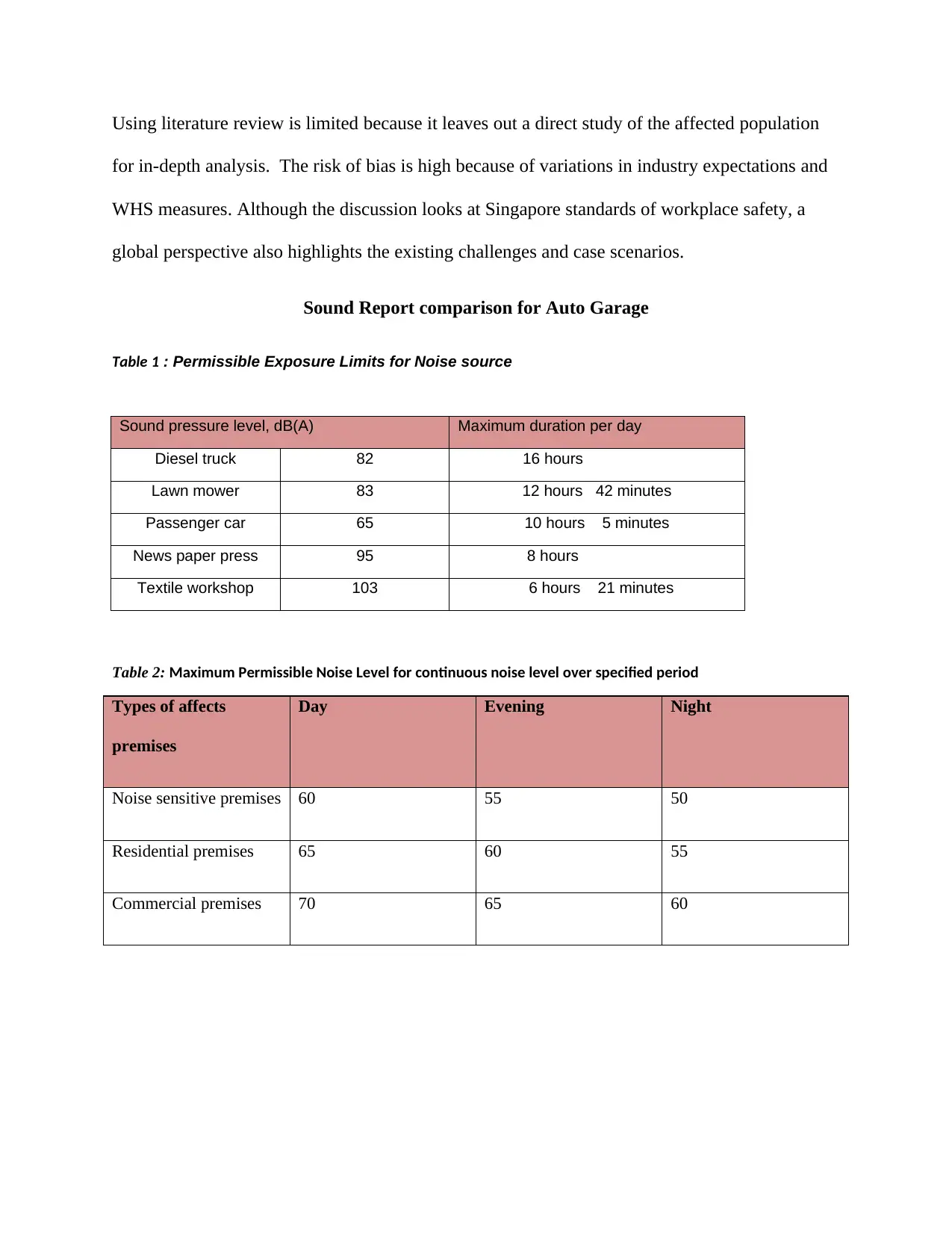
Using literature review is limited because it leaves out a direct study of the affected population
for in-depth analysis. The risk of bias is high because of variations in industry expectations and
WHS measures. Although the discussion looks at Singapore standards of workplace safety, a
global perspective also highlights the existing challenges and case scenarios.
Sound Report comparison for Auto Garage
Table 1 : Permissible Exposure Limits for Noise source
Sound pressure level, dB(A) Maximum duration per day
Diesel truck 82 16 hours
Lawn mower 83 12 hours 42 minutes
Passenger car 65 10 hours 5 minutes
News paper press 95 8 hours
Textile workshop 103 6 hours 21 minutes
Table 2: Maximum Permissible Noise Level for continuous noise level over specified period
Types of affects
premises
Day Evening Night
Noise sensitive premises 60 55 50
Residential premises 65 60 55
Commercial premises 70 65 60
for in-depth analysis. The risk of bias is high because of variations in industry expectations and
WHS measures. Although the discussion looks at Singapore standards of workplace safety, a
global perspective also highlights the existing challenges and case scenarios.
Sound Report comparison for Auto Garage
Table 1 : Permissible Exposure Limits for Noise source
Sound pressure level, dB(A) Maximum duration per day
Diesel truck 82 16 hours
Lawn mower 83 12 hours 42 minutes
Passenger car 65 10 hours 5 minutes
News paper press 95 8 hours
Textile workshop 103 6 hours 21 minutes
Table 2: Maximum Permissible Noise Level for continuous noise level over specified period
Types of affects
premises
Day Evening Night
Noise sensitive premises 60 55 50
Residential premises 65 60 55
Commercial premises 70 65 60
Paraphrase This Document
Need a fresh take? Get an instant paraphrase of this document with our AI Paraphraser
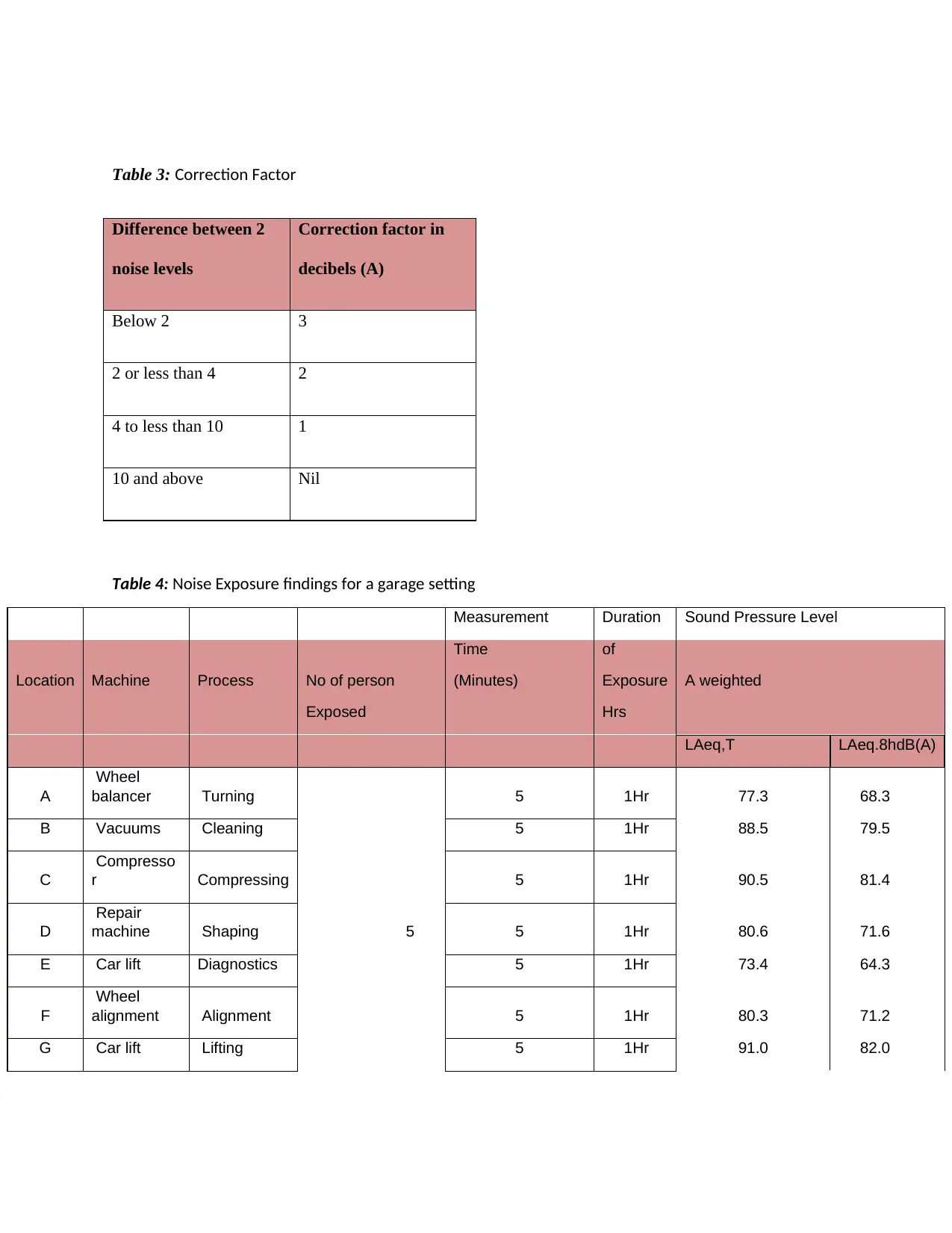
Table 3: Correction Factor
Difference between 2
noise levels
Correction factor in
decibels (A)
Below 2 3
2 or less than 4 2
4 to less than 10 1
10 and above Nil
Table 4: Noise Exposure findings for a garage setting
Measurement Duration Sound Pressure Level
Time of
Location Machine Process No of person (Minutes) Exposure A weighted
Exposed Hrs
LAeq,T LAeq.8hdB(A)
A
Wheel
balancer Turning 5 1Hr 77.3 68.3
B Vacuums Cleaning 5 1Hr 88.5 79.5
C
Compresso
r Compressing 5 1Hr 90.5 81.4
D
Repair
machine Shaping 5 5 1Hr 80.6 71.6
E Car lift Diagnostics 5 1Hr 73.4 64.3
F
Wheel
alignment Alignment 5 1Hr 80.3 71.2
G Car lift Lifting 5 1Hr 91.0 82.0
Difference between 2
noise levels
Correction factor in
decibels (A)
Below 2 3
2 or less than 4 2
4 to less than 10 1
10 and above Nil
Table 4: Noise Exposure findings for a garage setting
Measurement Duration Sound Pressure Level
Time of
Location Machine Process No of person (Minutes) Exposure A weighted
Exposed Hrs
LAeq,T LAeq.8hdB(A)
A
Wheel
balancer Turning 5 1Hr 77.3 68.3
B Vacuums Cleaning 5 1Hr 88.5 79.5
C
Compresso
r Compressing 5 1Hr 90.5 81.4
D
Repair
machine Shaping 5 5 1Hr 80.6 71.6
E Car lift Diagnostics 5 1Hr 73.4 64.3
F
Wheel
alignment Alignment 5 1Hr 80.3 71.2
G Car lift Lifting 5 1Hr 91.0 82.0
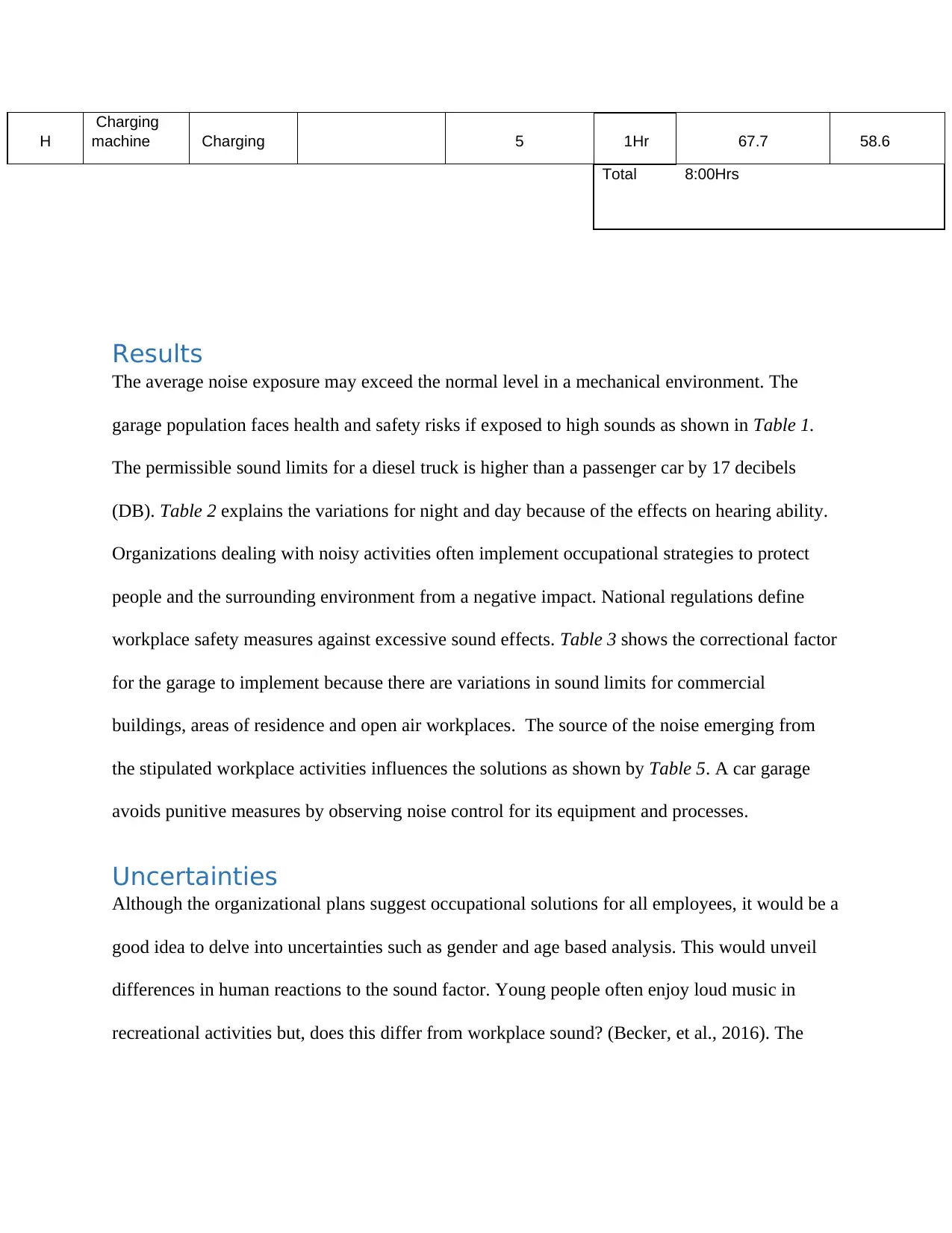
H
Charging
machine Charging 5 1Hr 67.7 58.6
Total 8:00Hrs
Results
The average noise exposure may exceed the normal level in a mechanical environment. The
garage population faces health and safety risks if exposed to high sounds as shown in Table 1.
The permissible sound limits for a diesel truck is higher than a passenger car by 17 decibels
(DB). Table 2 explains the variations for night and day because of the effects on hearing ability.
Organizations dealing with noisy activities often implement occupational strategies to protect
people and the surrounding environment from a negative impact. National regulations define
workplace safety measures against excessive sound effects. Table 3 shows the correctional factor
for the garage to implement because there are variations in sound limits for commercial
buildings, areas of residence and open air workplaces. The source of the noise emerging from
the stipulated workplace activities influences the solutions as shown by Table 5. A car garage
avoids punitive measures by observing noise control for its equipment and processes.
Uncertainties
Although the organizational plans suggest occupational solutions for all employees, it would be a
good idea to delve into uncertainties such as gender and age based analysis. This would unveil
differences in human reactions to the sound factor. Young people often enjoy loud music in
recreational activities but, does this differ from workplace sound? (Becker, et al., 2016). The
Charging
machine Charging 5 1Hr 67.7 58.6
Total 8:00Hrs
Results
The average noise exposure may exceed the normal level in a mechanical environment. The
garage population faces health and safety risks if exposed to high sounds as shown in Table 1.
The permissible sound limits for a diesel truck is higher than a passenger car by 17 decibels
(DB). Table 2 explains the variations for night and day because of the effects on hearing ability.
Organizations dealing with noisy activities often implement occupational strategies to protect
people and the surrounding environment from a negative impact. National regulations define
workplace safety measures against excessive sound effects. Table 3 shows the correctional factor
for the garage to implement because there are variations in sound limits for commercial
buildings, areas of residence and open air workplaces. The source of the noise emerging from
the stipulated workplace activities influences the solutions as shown by Table 5. A car garage
avoids punitive measures by observing noise control for its equipment and processes.
Uncertainties
Although the organizational plans suggest occupational solutions for all employees, it would be a
good idea to delve into uncertainties such as gender and age based analysis. This would unveil
differences in human reactions to the sound factor. Young people often enjoy loud music in
recreational activities but, does this differ from workplace sound? (Becker, et al., 2016). The
⊘ This is a preview!⊘
Do you want full access?
Subscribe today to unlock all pages.

Trusted by 1+ million students worldwide
1 out of 16
Related Documents
Your All-in-One AI-Powered Toolkit for Academic Success.
+13062052269
info@desklib.com
Available 24*7 on WhatsApp / Email
![[object Object]](/_next/static/media/star-bottom.7253800d.svg)
Unlock your academic potential
Copyright © 2020–2025 A2Z Services. All Rights Reserved. Developed and managed by ZUCOL.





